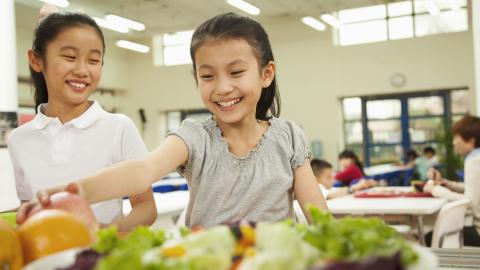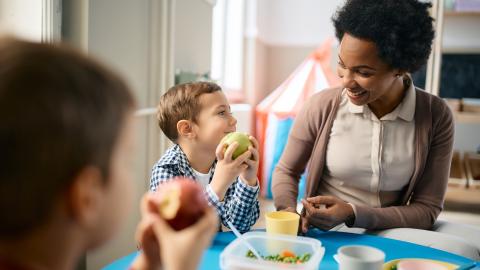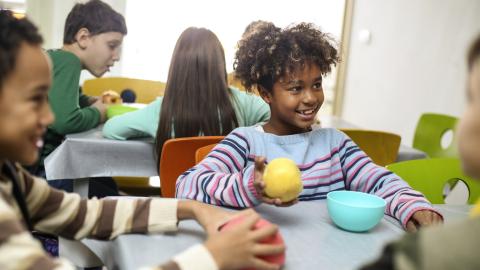Resource
School food environments

Food culture and food systems are complex. Find out how we can support children to eat well and nurture a healthy relationship with food in school and beyond.
Feeding and eating roles
Respect all foods students bring from home. Families may face barriers to accessing healthy foods, and the term “healthy” holds different meanings. To support families with meals and snacks, check out Lunches to Go - Quick and easy ideas for packed lunches
Trust that children naturally know how much food their bodies need. Follow the Division of Responsibility in Feeding: Students decide how much, in what order, and whether to eat from the foods adults have provided.
Do not pressure students to eat certain amounts or types of foods. Pressure can backfire and make it harder for children to learn to accept new foods.
Time and space to eat
- Ensure students have enough time to eat. Focus on providing regular, sit-down meal and snack opportunities rather than what or how much a student eats.
- Create safe and pleasant areas for students to gather and eat.
- Consider a "Play First Lunch.” Some schools find this leads to calmer lunchtimes.
Rewards and celebrations
Avoid using food as a reward. This sends the message that some foods are better than other foods and can teach students to eat when they are not hungry.
Consider ways to celebrate without food that is inclusive of all students.
Food and beverage sales
Refer to the Province of BC’s BC school food and beverage sales guidelines (PDF). These resources support schools with role modeling healthy eating in the classroom, school food programs, vending machines, and special events.
Food allergies
Aim to create “allergy-safe” or “allergy-aware” environments using the best strategies for your school. It is unrealistic to expect an “allergy-free” environment.
Ensure school policies include allergen avoidance strategies, communication plans, education and staff training, and emergency protocols.
Resources
-
-
Positive mealtimes
A short booklet with tools for eating with young children
-
Positive or negative, it’s still pressure
Ellyn Satter Institute
-
Nurturing Healthy Eaters in the Classroom
Ontario Dietitians in Public Health
-
Eating for Peak Performance
Written for youth athletes who are looking for nutrition tips on what to eat and drink to optimize sports performance.
-
-
-
Creating Positive Food Environments to Nurture Healthy Eaters
The food environment you create can play a considerable part in kids developing a healthy relationship with food that may have lifelong benefits.
-
Apply the Play First Lunch Model
-
-
-
Celebrating with healthy food
Tips to reinforce classroom food and nutrition lessons when celebrating special occasions.
-
Food-free rewards
Learn about food-free ways to reward children.
-
-
-
Province of BC’s school food and beverage sales guidelines
Resources to support schools with role modelling healthy eating in the classroom, school food programs, vending machines, and special events.
-
Tips and recipes for quantity cooking: Nourishing minds and bodies
-
Bake Better Bites
-
Should I be concerned about serving hot dogs at school?
-
-
-
All About Food Allergy
Food Allergy Canada has a new program for gr. 4-6 classrooms/teachers
-
Anaphylaxis in Schools and Other Settings
Canadian guidelines for anaphylaxis management
-
Anaphylaxis in Schools
30-minute online course for school staff
-




